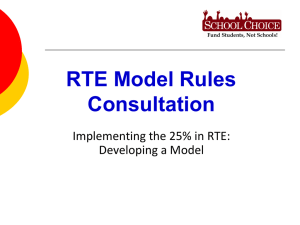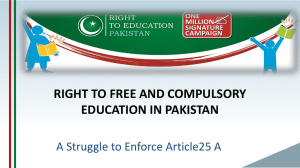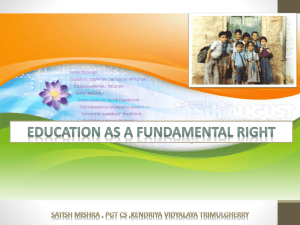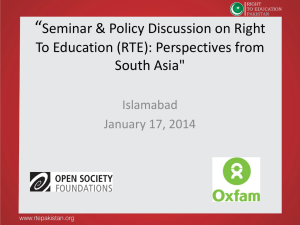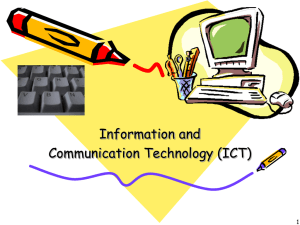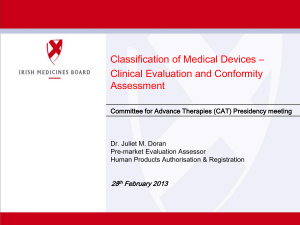Document
advertisement
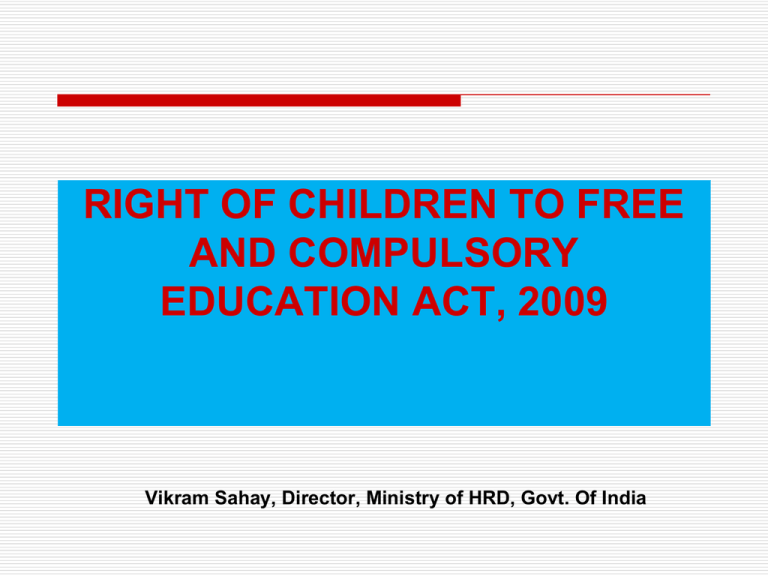
RIGHT OF CHILDREN TO FREE AND COMPULSORY EDUCATION ACT, 2009 Vikram Sahay, Director, Ministry of HRD, Govt. Of India Education a Fundamental Right : India Directive Principles of State Policy Supreme Court (1992) : Right to Education inherent in ‘Right to Life’ and ‘Right to Equality’ Article 21A (2002): “The State shall provide free and compulsory education to all children of the age Of six to fourteen years in such manner as the State may determine, by law.” Right of Children to Free and Compulsory Education Act, 2009 21A and RTE Act enforced w.e.f. 1st April, 2010 Exctract from Objectives of RTE Act “…..Provision of free and compulsory education of satisfactory quality to children from disadvantaged group and weaker sections is, therefore, not merely the responsibility of Schools run or supported by the appropriate Governments, but also of schools which are not dependent on Government schools.” Dimension 1.2 million schools 200 million children Child Labour Financial Commitment Disadvantaged and weaker section 8 million Children not in school Pluralistic society Right of Children Free and Compulsory admission, attendance, Completion of Elementary Education Removal of Financial barrier Compulsion on Government Duty of Parents Special provision for children with disabilities No Expulsion No detention Bars corporal punishment Mental harassment Special provision for Out-of-School children Teachers National level Teacher qualification norms Prohibits Private Tuition Prohibits Teacher deployment for Non-educational purpose Academic Responsibilities 1 maintain regularity and punctuality 2 complete prescribed curriculum in specified time 3 assess learning ability of each child; supplement additional instructions 4 Hold regular meetings with parents Teacher position and challenges 600,000 untrained teachers CHALLENGES 500,000 posts vacant Another 500,000 teachers required Rural-urban imbalance in deployment Imbalance in availability of TEIs Curriculum Reforms Assessment and Evaluation SHRDC programme on BSSFA, Islamabad, 18-29th April, 2011 7 Recent Initiatives Development of a new National Curriculum Framework on Teacher Education, linking with NCF, 2005 and the RTE Act, 2009 Model sylabii for elementary, secondary and Masters programmes in Teacher Education courses Preparation of a compendium of resource material for student-teachers Implications of RTE Act on ITP and CTD Development of State-specific distance TE courses for untrained teachers SHRDC programme on BSSFA, Islamabad, 18-29th April, 2011 8 Each School Infrastructure 1 one classroom for every teacher 2 barrier-free access 3 separate toilets for boys and girls 4 drinking water facility 5 playground 6 Boundary wall/fencing 7 Library 8 play material, games Academics 1 PTR 1:30 (Primary) 2 PTR 1:35 (U Primary) 3 Subject teachers in Upper primary 4 part-time instructors 5 200 working days (Pr.) 6 220 working days (u. Pr) 7 45 working hrs/week 8 TLM School Management Committee in Government schools to monitor school functioning Schools No capitation fees Penal Provisions No screening for admission No school Without recognition SOCIAL EQUITY ISSUES >/=25% admission in private schools from Children from disadvantaged/weaker section Free education to at least 25% children in Aided schools Curriculum Content/Principles Conform to constitutional values Make child free from fear, trauma, anxiety child-centred, child-friendly learning through activities instruction in child’s mother tongue as far as practicable Continuous and comprehensive evaluation No Board Examination till completion of EE Duties: Central Government Develop national framework of curriculum Develop and enforce standards of teacher training Lay down minimum teacher qualification norms Prepare estimates of capital and recurring expenditure Provide resources to State Governments Duties: Appropriate Government, Local Authority Ensure Free and compulsory education Establish neighbourhood school within 3 years Special training for un-enrolled and drop-out children Monitoring of admission, attendance, completion of EE Timely prescription of curriculum, courses of study, Teachers’ training Protection of Right Local Authority – First level of Grievance redressal Grievance for violation of rights of the child State Commissions for Protection of Child Rights Parents Guardian Any person National Commission for Protection of Child Rights Steps taken for implementation Model Rules circulated; Central Rules notified 27 StatesUTs have notified State Rules Rs 2.31 lakh crore approved for 5 years New implementation norms notified New teacher qualification norms; Teacher Eligibility Test Steps taken for implementation 27 States have notified prohibition of corporal punishment 25 States notified prohibiting screening and capitation fees 25 States notified banning Board exams in class VIII 25 States have notified academic authority Teacher Qualifications Class I-V 50% in Class XII with 2-year D.Ed 50% in Class XII with 4-year B.El.Ed 50% in Class XII with 2-year D.Ed (Special Education) Class VI-VIII Graduation with 2-year D.Ed 50% in Graduation with 1-year B.Ed 50% in Class XII with 4-year B.El.Ed 50% in Graduation with 1-year B.Ed (Special Education) Pass in Teacher Eligibility Test What Government expects from unaided schools Follow the admission Guidelines issued by the Government Ban capitation fees, private tuition Adhere to the norms and standards in the Schedule Admit children from disadvantaged group and weaker section Appoint persons who have passed TET as school teachers What Government expects from unaided schools No detention, no expulsion of children in classes I-VIII No corporal punishment to children Seek recognition from the State Government Follow curriculum based on principles enshrined in section 29 Orient teachers towards their duties under the RTE Act Teachers Touch Tomorrow Thank You For further details visit : www.education.nic.in vikramsahay7@gmail.com 20

